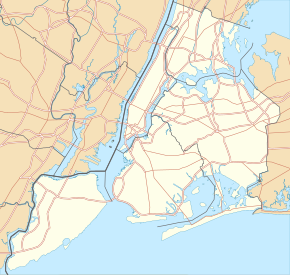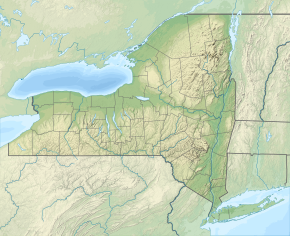
Back معركة لونغ آيلند Arabic Batalla de Long Island AST لانق آیلند دؤیوشو AZB Битка на Лонг Айлънд Bulgarian Batalla de Long Island Catalan Bitva o Long Island Czech Schlacht von Long Island German Batalo de Long-Insulo EO Batalla de Long Island Spanish Long Islandi lahing ET
| Battle of Long Island | |||||||||
|---|---|---|---|---|---|---|---|---|---|
| Part of the American Revolutionary War | |||||||||
 The Battle of Long Island, a 21st-century portrait of the battle | |||||||||
| |||||||||
| Belligerents | |||||||||
|
|
| ||||||||
| Commanders and leaders | |||||||||
|
|
| ||||||||
| Strength | |||||||||
| 20,000[2] | 10,000[3] | ||||||||
| Casualties and losses | |||||||||
|
64 killed 293 wounded 31 missing[4][5] | 2,179 killed, wounded or captured[6] | ||||||||
Location within New York City | |||||||||
The Battle of Long Island, also known as the Battle of Brooklyn and the Battle of Brooklyn Heights, was an action of the American Revolutionary War fought on August 27, 1776, at and near the western edge of Long Island in present-day Brooklyn. The British defeated the Continental Army and gained access to the strategically important Port of New York, which they held for the rest of the war. It was the first major battle to take place after the United States declared its independence on July 4, 1776, in Philadelphia. It was the largest battle of the Revolutionary War in terms of both troop deployment and combat.
After defeating the British in the siege of Boston on March 17, Continental Army commander-in-chief George Washington relocated his army to defend the port city of New York, located at the southern end of Manhattan Island. Washington understood that the city's harbor would provide an excellent base for the Royal Navy, so he established defenses there and waited for the British to attack. In July, the British, under the command of General William Howe, landed a few miles across the harbor on the sparsely populated Staten Island, where they were reinforced by a fleet of ships in Lower New York Bay over the next month and a half, bringing their total force to 32,000 troops. Washington knew the difficulty in holding the city with the British fleet in control of the entrance to the harbor at the Narrows, and accordingly moved the bulk of his forces to Manhattan, believing that it would be the first target.
On August 21, the British landed on the shores of Gravesend Bay in southwest Kings County, across the Narrows from Staten Island and more than a dozen miles south of the established East River crossings to Manhattan. After five days of waiting, the British attacked the American defenses on the Guan Heights. Unknown to the Americans, however, Howe had brought his main army around their rear and attacked their flank soon after. The Americans panicked, resulting in twenty percent losses through casualties and capture, although a stand by 400 Maryland and Delaware troops prevented greater losses. The remainder of the army retreated to the main defenses on Brooklyn Heights. The British dug in for a siege, but on the night of August 29–30, Washington evacuated the entire army to Manhattan without the loss of supplies or a single life. The Continental Army was driven out of Manhattan entirely after several more defeats and was forced to retreat through New Jersey to Pennsylvania.
- ^ Syrett 2005, p. 61.
- ^ Lengel 2005, p. 139.
- ^ Lengel 2005, p. 140 – Figure indicates how many troops were on Long Island total. Only 3,000 troops were on the Guana Heights, where the British made their assault.
- ^ Cite error: The named reference
m179was invoked but never defined (see the help page). - ^ According to Lord Howe report 31 (1 officer and 30 Grenadiers of the Marines) were captured Diary of the Revolution p. 304
- ^ Cite error: The named reference
m180was invoked but never defined (see the help page).

